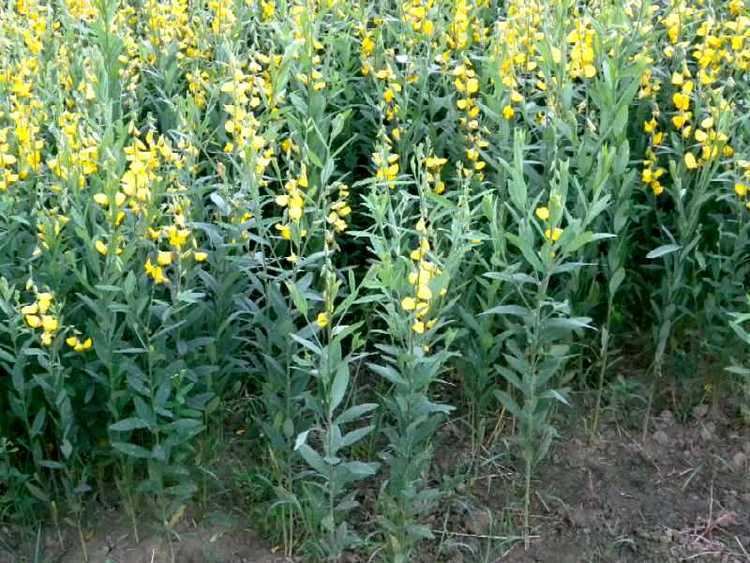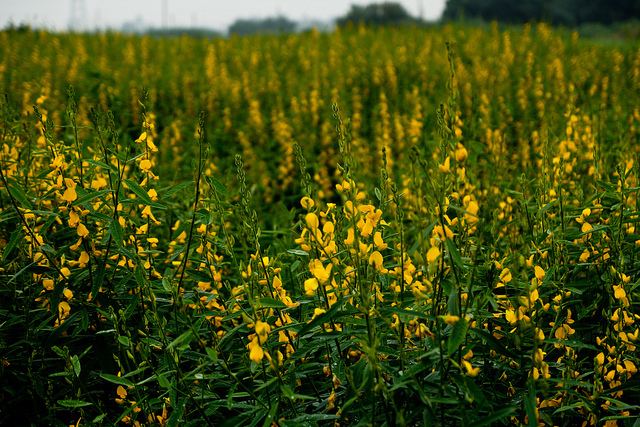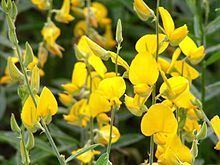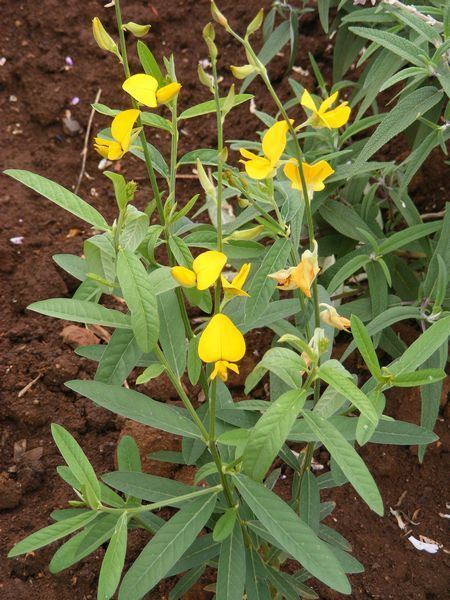Tribe Crotalarieae Rank Species | Genus Crotalaria Higher classification Crotalaria | |
 | ||
Similar Crotalaria, Legumes, Canavalia ensiformis, Velvet bean, Canavalia | ||
Crotalaria juncea, known as brown hemp, Indian hemp, Madras hemp, or sunn hemp, is a tropical Asian plant of the legume family (Fabaceae). It is generally considered to have originated in India.
Contents
- Description
- Modern Applications
- Phytoremediation on Crotalaria juncea
- Effects of Copper on Crotalaria juncea
- Phosphate and Rhizophagus clarus Altering on Crotalaria juncea
- References

It is now widely grown throughout the tropics and subtropics as a source of green manure, fodder and lignified fiber obtained from its stem. Sunn hemp is also being looked at as a possible bio-fuel. It can be an invasive weed and has been listed as a noxious weed in some jurisdictions.
It bears yellow flowers and elongate, alternate leaves.
Description
Annual, c. 100–1000 cm tall.
Many ascending branches, pubescent.

Leaf simple, c. 2.5-10.5 cm long, c. 6–20 mm broad, linear or oblong, obtuse or subacute, apiculate, pubescent on both sides, hairs appressed, silky.
Petiole c. 1.2-2.5 mm long; stipules almost absent.

Inflorescence an erect terminal and lateral raceme, up to 30 cm long, 12-20-flowered. Pedicel c. 3–7 mm long. Bract minute; bracteoles 2, below the calyx. Calyx c. 1.8-2.0 cm long, pubescent, teeth linear-lanceolate. Corolla bright yellow. Vexillum ovate-oblong, slightly exserted.
Fruit c. 2.5-3.2 cm long, sessile, pubescent, 10-15-seeded. Fl.Per. May–September.
Modern Applications
Crotalaria juncea has many practical applications in the modern world. First, it is a source of natural fibre. It is used for cordage, fishing nets, ropes, and more. It is particularly beneficial because of its resistance to root-knot nematodes and is also a soil improving crop via nitrogen fixation. The Sunnhemp Research Station of Uttar Pradesh further researched Crotalaria juncea’s genotypic impact on fibre yield. Four different genotypes of Crotalaria juncea were observed for three years to determine which genotype would yield in a high fibre yield. Important data that was collected across the plant genotypes include height (cm), basal diameter (mm), green biomass weight (q/ha), fibre weight (q/ha), and stick weight (q/ha). Out of the four genotypes, namely SUIN-029, SUIN-080, SUIN-037, and SUIN-043, SUIN-029 was superior in resulting in a high fibre yield. This genotype can even be used as a template for future breeding.

Another practical application of Crotalaria juncea includes fuel. Crotalaria juncea holds a relatively high fuel value. In fact, a process optimization method for the extraction of oil from Crotalaria juncea is being researched in order to utilize the fuel value in Crotalaria juncea. The current method of oil extraction is known as the soxhlet based extraction which has an oil yield of 13% in four hours at 37 degrees Celsius. However, a novel three-phase partitioning based extraction shows an oil yield of 37% in two hours at 37 degrees Celsius. Furthermore, the optimization factors that were identified include ammonium sulphate and butanol, pH, and temperature, and these factors impact the oil yield.
Furthermore, Crotalaria juncea has applications in the agricultural field since it impacts common food production. Crotalaria juncea is identified as a plant that is an important summer cover crop in southeastern United States. The allelopathic effects of Crotalaria juncea on weeds, vegetable crops, and cover crops were observed via greenhouse and growth chamber experiments. Crotalaria juncea, reduced both the germination and seedlings of various crop species (bell pepper, tomato, onion, and others). The allelochemical activity in Crotalaria juncea was in the leaves and remained active for 16 days after harvest. Furthermore, Crotalaria juncea’s allelochemical effect may have practical applications for weed management.
Similarly, Crotalaria juncea can be used to improve nutrient patterns in agricultural plants. For instance, soil fertility in Paraiba, Brazil is generally low. To rectify this, animal manure is often used to supply agricultural crops with nutrients. However, researchers in Brazil hypothesized that planting and incorporating Crotalaria juncea with animal manure could enhance the nutrient mineralization pattern for agricultural crops. Field and greenhouse experiments were used to test this hypothesis. After measuring the amounts of Nitrogen, Phosphorus, and Potassium in the soils, it was discovered that Crotalaria juncea along with only half the usual dose of goat manure produced the best results. This is because soils that consisted of this composition avoided immobilization of nitrogen while increasing the levels of phosphorus and potassium within the soil. In other words, Crotalaria juncea was able to improve the overall nutrient mineralization pattern for agricultural crops.
Additionally, other research also observed Crotalaria juncea’s potential in being used as an organic compost. Researchers in Brazil looked into the best composition of organic compost using various combinations of Crotalaria juncea and Napier grass. The objective was to find the mixture between Crotalaria juncea and Napier grass that would yield the highest vegetable seedling production. More specifically, the vegetable seedling production of lettuce, beetroot, and tomatoes was measured by observing the shoot height, fresh mass production in shoots and dry matter, and leaf number. The various compounds that were observed include, 100% Crotalaria juncea, 66% Crotalaria juncea with 33% Napier, 33% Crotalaria juncea with 66% Napier, 100% of Napier, 33% Crotalaria juncea with 66% Napier where 5% of the mass is cattle manure, Crotalaria juncea 33% with 66% Napier which includes 100 liters of 5% dilute Agrobio (biofertilizer), and finally, 100% Napier which also includes 100 liters of 5% dilute Abrobio. The compost with 66% Crotalaria juncea and 33% Napier grass was superior to other combinations since this particular combination yielded the greatest production of lettuce, beet, and tomato seedlings.
Phytoremediation on Crotalaria juncea
There are several methods that have been shown to be effective as in decontamination and remediation of contaminated soils. A highly applicable method of soil remediation known as phytoremediation has been specifically shown to be effective as when used in soils contaminated with heavy metals. Phytoremediation has been demonstrated to be effective as for correcting Crotalaria juncea found in soils contaminated with herbicides. The method of phytoremediation functions effectively in decontamination and remediation by using microorganisms and plants to remove, transfer, stabilize, or destroy harmful elements. Crotalaria juncea found in soils contaminated with herbicides revealed high phytoremediation capacity. In addition, phytoremediation is effective in removal of copper, which has been identified as a metal strongly present in the soil of Crotalaria juncea.
Effects of Copper on Crotalaria juncea
Cultivated soil high in copper levels has proven to be effective in increasing the growth of Crotalaria juncea. However, an excess of copper in plant tissues has demonstrated the potential of affecting both physiological and biochemical processes including photosynthesis. Toxicity resulting from excessive copper has also resulted in altered effects that have been found to affect the cellular and molecular levels of the plant. Excessive copper levels can ultimately result in depletion of necessary nutrients. This nutrient deficiency occurs when the interactions of copper with sulfhydryl groups of enzymes and proteins inhibit enzyme activity or result in changes in the structure or replacement of key elements. The structures of chloroplasts have been affected by the excess of copper, which ultimately resulted in decreased pigmentation levels of Crotalaria juncea. There are, however, studies that have indicated that Crotalaria juncea has a high tolerance to copper concentrations in the soil and root systems which are beneficial traits for phytostabilization programs.
Phosphate and Rhizophagus clarus Altering on Crotalaria juncea
Studies have also shown that phosphate and Rhizophagus clarus are capable in altering the physiological responses of Crotalaria juncea that is found in soil high in copper levels. Phosphate has been demonstrated to be effective in reducing the level of toxicity in Crotalaria juncea, resulting in promotion of plant growth. When the application of phosphate is coupled with the inoculation of Rhizophagus clarus, the result is a synergistic effect that allows copper toxicity levels to be reduced through various mechanisms. This ultimately allows for the increased growth of Crotalaria juncea in spite of having been cultivated in high levels of copper.
Another effective approach in decreasing the levels of copper in Crotalaria juncea is with the use of arbuscular mycorrhizal fungi (AMF). Phosphate uptake is significantly improved in the presence of AMF, which functions to effectively reduce the amount of available heavy metals. The symbioses with AMF and soil supplementation of phosphate allows for the promotion growth of Crotalaria juncea. Despite the high levels of copper in the soil of Crotalaria juncea, mechanisms have been determined which can reverse the toxic effects of copper and allow for growth of the plant.
